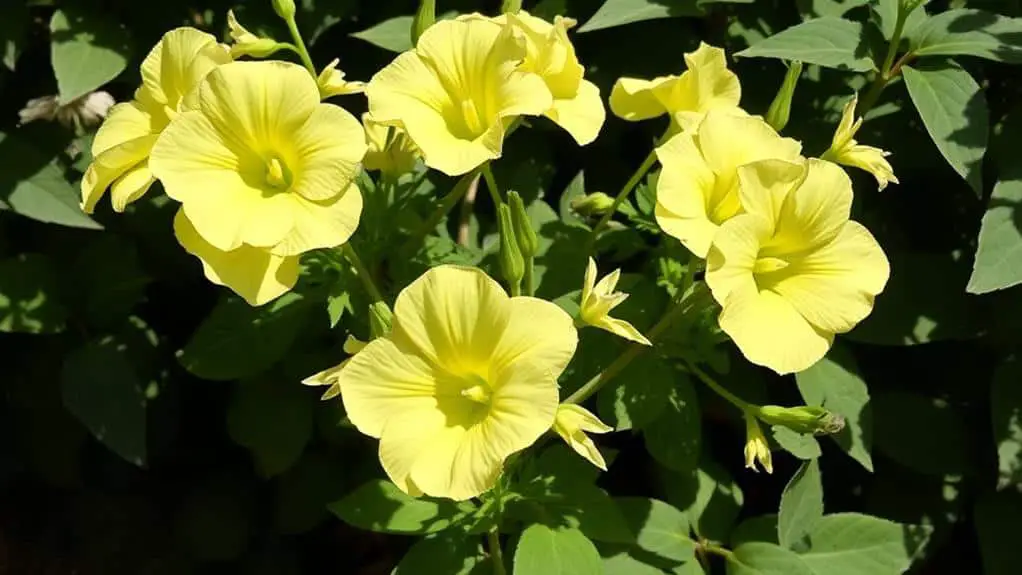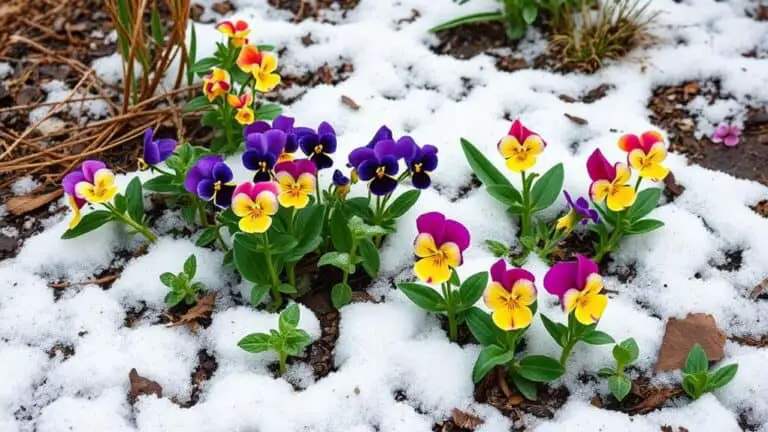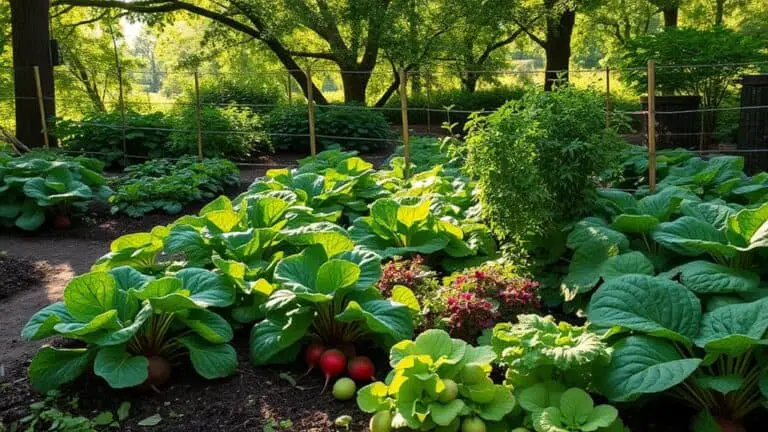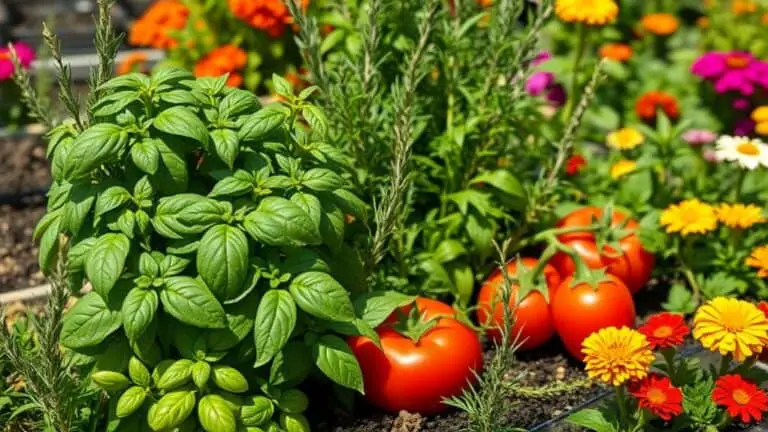Signs That Your Petunias Are Not Getting Enough Sun
I've noticed my petunias aren't thriving as they should, and I suspect insufficient sunlight might be the culprit. Have you ever seen your petunias develop spindly, leggy growth? This stretching towards any available light is a clear sign they're craving more sun. Additionally, the blooms seem fewer and the leaves have started yellowing, which isn't a good sign. If you're seeing similar issues, it might be time to reflect on their light exposure. Let's explore further to determine if relocating them to a sunnier spot could be the answer to rejuvenating your plants.
Spindly and Leggy Growth
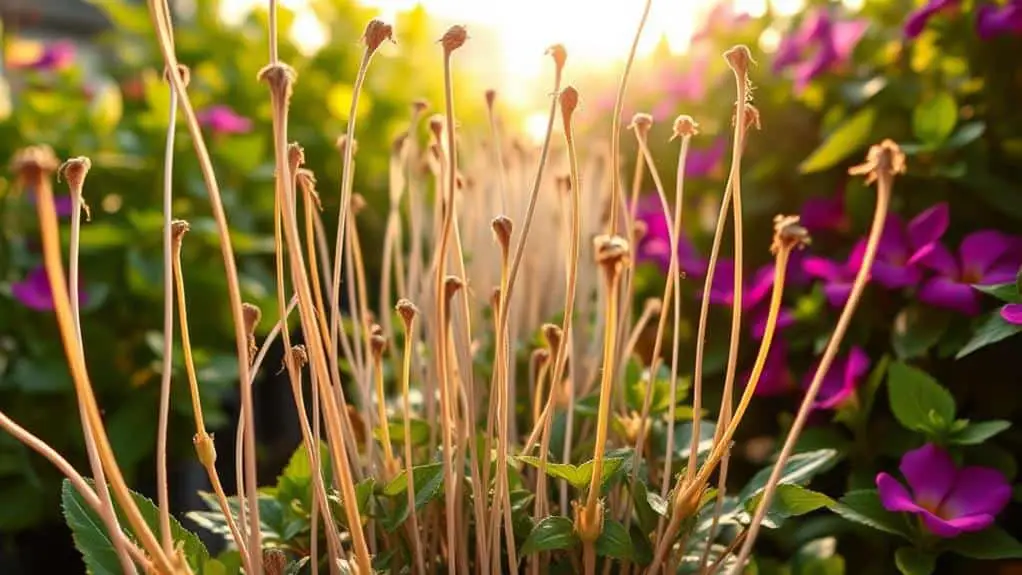
When petunias don't get at least five hours of direct sunlight daily, they often exhibit spindly and leggy growth. This happens because the plants stretch towards any available light, resulting in weak, elongated stems. Insufficient light is usually the main culprit behind this issue.
Healthy petunias should have a robust and bushy appearance, but without adequate sunlight exposure, they struggle.
To keep them looking their best, make sure they receive enough light. Overwatering can worsen the problem, so it's important to balance moisture levels.
Reduced Blooming
If your petunias aren't blooming as much as you'd like, they mightn't be getting enough sun.
Petunias need at least 6 hours of direct sunlight each day to produce plenty of flowers.
Without enough light, you'll notice fewer buds and stunted growth patterns, which can be quite frustrating.
Fewer Flower Buds
Noticing fewer flower buds on your petunias? You might wonder what's going wrong. Petunias need at least 6 hours of direct sunlight daily to produce those beautiful blooms we all love. If they're not getting enough sun, they'll show it by having fewer flower buds. Instead of bursting with color, your petunias might focus mainly on growing leaves.
Proper sunlight is essential. When petunias don't get what they need, they might develop leggy stems, yellowing leaves, and wilting flowers. These early signs warn you of a bigger issue.
If you notice reduced blooming, check their light exposure. Move them to a sunnier spot to help them thrive. Remember, healthy petunias are prolific bloomers with plenty of sunlight.
Stunted Growth Patterns
Seeing fewer flower buds on your petunias is a clear sign that something's off, and stunted growth patterns often follow.
Petunias need at least 6 hours of direct sunlight daily. Without enough sunlight, they may suffer from stunted growth and reduced blooming.
You might notice:
- Leggy, spindly stems as the plants stretch toward light
- Fewer blooms and shorter plants
- Yellowing leaves
- Wilting flowers
It's critical to guarantee your petunias get enough sunlight to thrive.
If you notice these signs, try relocating them to a sunnier spot.
Healthy petunias not only look better but also bloom more frequently, adding vibrant color to your garden.
Keep an eye on their sunlight exposure to enjoy lush, blooming petunias!
Yellowing Leaves
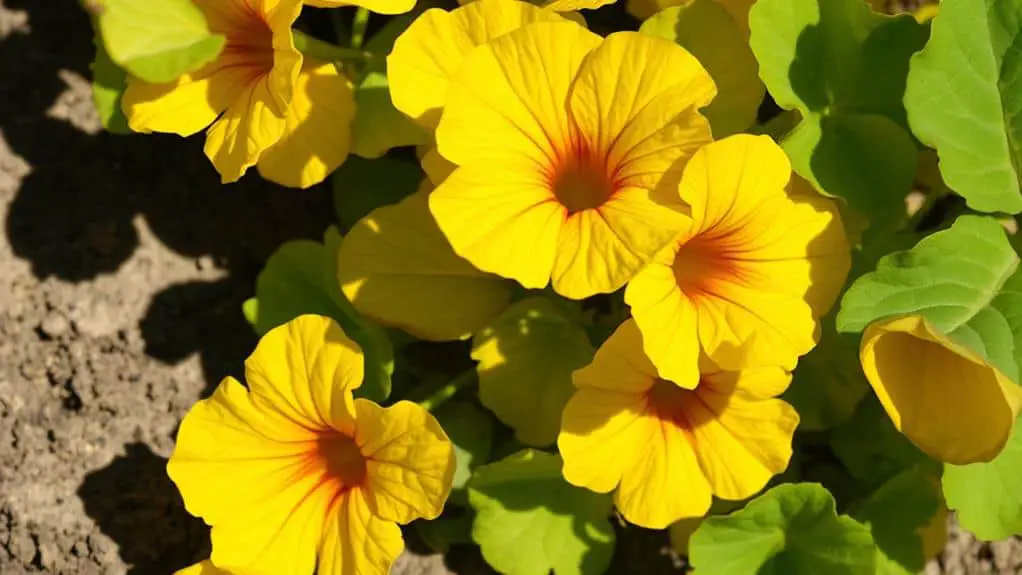
As you tend to your garden, you might notice your petunias' leaves turning yellow, a clear sign that they're not getting enough sunlight.
Petunias need a minimum of 6 hours of direct sun daily to thrive. When they don't get enough light exposure, chlorophyll production drops, causing the leaves to yellow.
This yellowing leaves issue happens because the plant lacks the energy needed for growth. Over time, these leaves may even drop off, indicating severe light deficiency.
Also, watch for leggy growth, where stems stretch towards any light source, making the foliage weak and yellow.
To help your petunias, monitor their light exposure and consider relocating them to a sunnier spot in your garden.
Wilted Flowers
When your petunias have wilted flowers, it's often a sign they're not getting enough sunlight.
These plants need at least 6 hours of direct sunlight daily to produce the energy they need for strong growth and blooming.
If they're in the shade for too long, you'll notice symptoms like wilting, leggy stems, and yellowing leaves, indicating they're stressed and need more light.
Light Exposure Deficiency
Petunias thrive on sunlight, needing at least six hours of direct exposure each day to maintain their health.
When petunias don't get enough sunlight per day, you'll notice some clear signs of insufficient light exposure.
- Leggy growth: Your petunias might start growing tall and spindly, stretching towards any available light source.
- Yellowing leaves: Without enough light, leaves can turn yellow, signaling stress.
- Wilted flowers: Lack of sunlight weakens the plants, leading to droopy blooms.
- Susceptibility to disease: Shaded petunias often stay damp, making them prone to issues like powdery mildew.
Keep an eye on your petunias' light exposure and consider relocating them to sunnier spots if needed.
Your plants will thank you with vibrant, healthy blooms!
Inadequate Energy Production
You might notice your petunias' flowers wilting despite regular watering, and it's not just the heat to blame.
Inadequate sunlight can lead to energy depletion, causing your petunias to struggle. They need at least 6 hours of direct sunlight daily to thrive.
When they don't get enough light, they can't photosynthesize effectively, which leads to wilted flowers and yellowing leaves.
If your petunias receive less than 5 hours of sunlight, you might see fewer blooms and spindly growth.
On especially hot days, continuous wilting indicates they're not getting the energy they need from sunlight.
Stressed Plant Symptoms
Often, wilted flowers are the first telltale sign that your petunias are stressed and not getting enough sunlight.
When petunias don't receive adequate light, they struggle to produce the energy needed for healthy blooming. This lack of energy leads to wilting, where the flowers droop and lose their vibrant look.
You might also notice:
- Drooping flowers: They lose their color and structure.
- Leggy growth: Stems stretch towards any available light, making the plant look spindly.
- Consistent wilting: Especially on hot days, indicating hydration issues.
- Reduced blooming: Less sunlight means fewer flowers.
To help your petunias thrive, monitor their health closely and consider relocating them to a sunnier spot if you see these signs.
Increased Disease Susceptibility
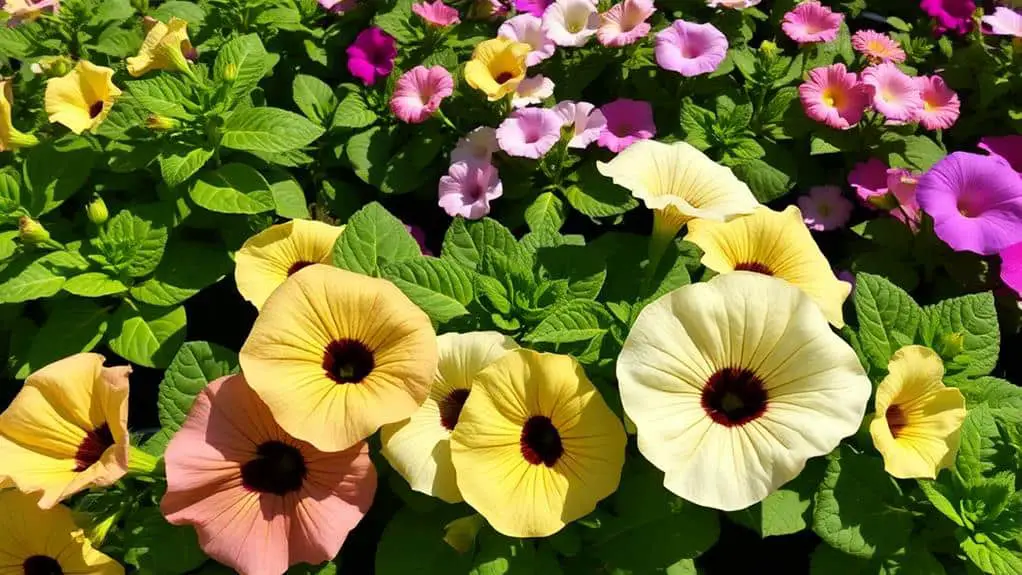
Inadequate sunlight leaves petunias highly susceptible to various diseases. When petunias don't get full sun, they become vulnerable to issues like powdery mildew, which thrives in shaded, humid conditions.
Insufficient sunlight weakens petunias, making them less resilient and more prone to pests and diseases. Research shows that petunias exposed to less than five hours of sunlight are at a higher risk of root rot due to poor drainage and excessive moisture retention in the soil.
Lack of adequate light can also lead to leggy growth, reducing airflow around the leaves and facilitating fungal infections.
Ensuring your petunias receive full sun not only helps them grow robustly but also bolsters their immune systems, making them stronger and healthier.
Stretching Towards Light
If you notice your petunias have leggy, spindly stems and seem to be stretching towards the light, they're likely not getting enough sun.
This stretching is a clear indicator that your plants need more than the 5-6 hours of direct sunlight required each day.
To correct this, try moving your petunias to a sunnier spot where they can receive adequate light, helping them become bushier and healthier.
Indicators of Light Deficiency
Petunias that don't get enough sunlight can show clear signs of light deficiency, with one of the most telling indicators being their leggy or spindly growth.
When petunias need more sunlight, they often stretch towards the nearest light source, resulting in elongated stems.
Ideally, petunias need at least 6 hours of full sun daily to produce vibrant blooms.
Here are some indicators your petunias mightn't be getting enough light:
- Elongated stems: Stems grow longer and thinner.
- Fewer blooms: Lack of flowers or reduced number of blooms.
- Yellowing leaves: Leaves may turn yellow due to stress.
- Sparse foliage: Overall weak and unbalanced appearance.
Corrective Measures Required
A clear understanding of the corrective measures required for petunias stretching towards light can make all the difference in their growth and bloom.
Petunias grow best in full sunlight, needing at least 6 hours of direct sunlight daily. If your petunias have leggy, spindly stems, they're stretching towards light. Move them to a sunnier spot.
Monitor their growth; if they lean or tilt, they need more light. Adjust their position as needed. Use reflective materials or light-colored surfaces nearby to boost light, especially in shaded areas.
Pruning back leggy parts can help, redirecting energy to healthier sections. These simple corrective measures will guarantee your petunias thrive and flourish beautifully.
Overwatering Issues

When dealing with petunias, overwatering can sneakily undermine your efforts, causing more harm than good.
It's easy to mistake signs of overwatering for insufficient sunlight, but the issues are distinct. Overwatering can lead to leggy, spindly growth as the plants stretch towards light while their roots drown.
Here are some signs to watch for:
- Yellowing leaves: This often signals too much water.
- Wilting flowers: Even when the soil is wet, wilting can occur.
- Decline in plant vigor: Your petunias might look tired and weak.
- Root rot: This can stunt growth and reduce blooming capabilities.
To guarantee healthy growth and vibrant blooms, maintain well-draining soil and only water when the top inch feels dry.
Consistency is key!
Weak Stem Structure
Ever noticed how your petunias' stems seem to lack strength and vigor? This weak stem structure might be due to not getting enough sunlight. Petunias need at least 6 hours of direct sunlight daily. Without it, they develop leggy stems as they stretch towards the light. These elongated stems can make your plants more prone to damage from wind or heavy rain. If petunias stop getting enough sunlight, they won't just have weak stems; they might also stop blooming.
To help you understand the signs better, here's a quick table:
| Sign | Cause | Solution |
|---|---|---|
| Weak stem structure | Not enough sunlight | Move to sunnier spot |
| Leggy stems | Insufficient light exposure | guarantee 6+ hours of sunlight |
| Reduced blooms | Lack of direct sunlight | Position in full sun |
Relocating your petunias to a sunnier spot will help them grow stronger and healthier.
Poor Flower Vibrancy
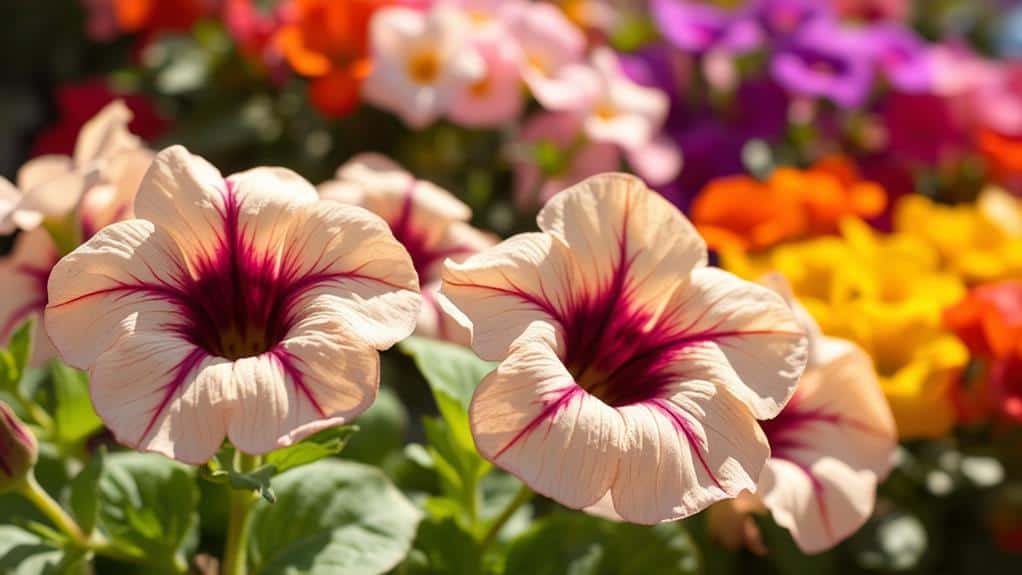
Poor flower vibrancy in petunias is often a telltale sign that they're not getting enough sunlight.
Petunias need at least six hours of direct sun daily to thrive and keep your petunias blooming with vibrant colors. When they get less light, their flowers can appear dull or washed out, indicating poor health.
You might notice more leaves than blooms or even yellowing leaves and spindly growth.
To guarantee your petunias are in ideal conditions, watch for these signs:
- Dull, pale flowers
- Fewer blooms than usual
- Yellowing leaves
- Spindly growth
Relocating for Better Sun
Noticing your petunias' flowers looking dull and their growth becoming spindly can be disheartening. If you're seeing these signs, relocating your petunias to a spot with full sun can make a big difference.
They need at least 6 hours of direct sunlight daily. Morning sunlight is especially good, so find a place where they get early sun and some afternoon shade.
When planting them in the new location, guarantee the soil is well-drained and they've enough space. This will help them thrive.
Keep an eye on the sunlight throughout the growing season. If the sun's path changes, you might need to adjust their position to guarantee they get more sunlight.
Your petunias will thank you!
Frequently Asked Questions
What Will Happen if Petunias Do Not Get Full Sun?
If petunias don't get full sun, their growth becomes spindly, flower color dulls, and leaf health declines. They're more susceptible to diseases like powdery mildew and root rot, leading to poor overall performance and shorter lifespan.
How to Tell if a Plant Is Not Getting Enough Sun?
I can tell my petunias aren't getting enough sun by observing leggy stems, yellowing leaves, and fewer blooms. Understanding their sunlight requirements, I know proper light exposure is essential for healthy petunia growth and minimal shade tolerance.
What Do Overwatered Petunias Look Like?
When my petunias are overwatered, I notice petunia leaf discoloration with yellowing leaves. Drooping petunia stems become soft and mushy. Root rot symptoms appear, and there's petunia growth stunting as they struggle in constantly wet soil.
Should You Water Petunias Every Day?
I don't water my petunias every day. Petunia watering frequency depends on their growth stages and sun requirements. One of my key petunia care tips is to check soil moisture regularly and guarantee proper drainage to avoid overwatering.
Conclusion
So, don't worry if your petunias aren't looking their best right now. It's easy to spot the signs of too little sunlight, like yellow leaves or spindly growth, and take action. Try moving them to a sunnier spot or adjusting their care routine. You've got this! With a little attention, your petunias will bounce back, bringing color and joy to your garden. Keep observing and learning, and your gardening skills will keep growing, too!

